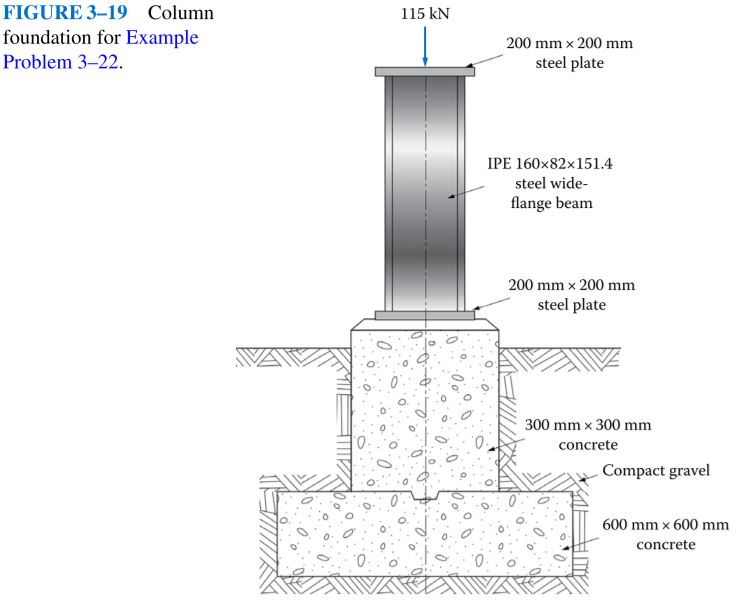Question 3.22: Figure 3–19 shows a column resting on a foundation and carry...
Figure 3–19 shows a column resting on a foundation and carrying a load of 116 kN. Determine if the bearing stresses are acceptable for the concrete and the soil. The concrete has a specified rated strength of 13.8 MPa, and the soil is compact gravel.

Learn more on how we answer questions.
Objective Determine if bearing stresses on the concrete and the soil are safe.
Given Foundation shown in Figure 3–19: Load = F = 116 kN = 116 000 N.
For concrete, f_{c}^{'} =138 \times 10^{6} N/m^{2}
For soil (compact gravel), σ_{bd} = 0.38 MPa (Table 3–7).
Analysis and Results For concrete, the load is transferred from the column to the concrete through the 200 mm square steel plate ( A_{1} = 40 000 mm²). But the concrete pier is 300 mm square
( A_{2} = 90 000 mm²). Therefore, the bearing load is on less than the full area of the concrete. Then, from Table 3–7,
\sigma_{bd} = Kf_{c}^{'} = 0.34 \sqrt{ \frac {A_{2}}{A_{1}}}f_{c}^{'} =0.34 \sqrt{ \frac {90 000}{4000}}f_{c}^{'} = 0.510 f_{c}^{'}
Note that K < 0.68. Then,
\sigma_{bd} = 0.510(13.8 MPa) = 7.0 MPA
The bearing stress exerted on the concrete by the steel plate at the base of the column is
\sigma_{b} = \frac{F}{A_{b}} =\frac{116 000 N}{40 000 mm²} = 2.9 MPa < \sigma_{bd}
Thus, the bearing stress on the concrete is acceptable.
For the soil (gravel) at the base of the foundation,
\sigma_{b} = \frac{F}{A_{b}} =\frac{116 000 N}{360 000 mm²} = 0.32 MPa
This is acceptable because the allowable bearing stress for compact gravel is 0.38 MPa as shown in Table 3–7.
| TABLE 3–7 Allowable bearing stresses on masonry and soils for use in this book. | ||
| Allowable bearing stress, \sigma_{bd} | ||
| Material | psi | MPa |
| Sandstone and limestone | 400 | 2.76 |
| Brick in cement mortar | 250 | 1.72 |
| Solid hard rock | 350 | 2.41 |
| Shale or medium rock | 140 | 0.96 |
| Soft rock | 70 | 0.48 |
| Hard clay or compact gravel | 55 | 0.38 |
| Soft clay or loose sand | 15 | 0.10 |